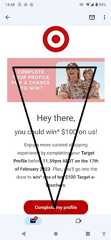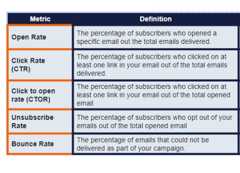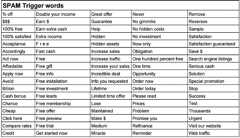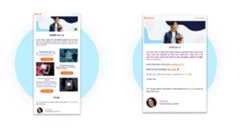

Contents:
Guess how many emails were sent and received in 2021?320 billion. Yes, that’s right.
If some of those emails came from your business and didn’t get the results you were hoping for, then this guide is for you.
Email has been around the longest of all digital marketing channels, before social media, even before display ads.
In fact, thefirst email marketing campaign can be traced back to 1978, when a company called Digital Equipment Corp. sent a mass promotional email to 400 recipients. According to legend, that email campaign resulted in $13 million in sales, which is a pretty neat ROI.
A lot has changed since then, but the end goal of email marketing remains the same: clicks, conversions, sales.
Let’s kick off this email marketing guide by looking at the different elements that make up an email, and how to make each of them work together and work for you.
Over the years, you’ve received thousands of emails, and opened many of them, but you might not have taken the time to consider each element of the email format and what its purpose is. So here goes.
When an email lands in a customer’s inbox, they will see three things:

These three elements are all ways that the email communicates its initial message to the reader.
When the reader clicks on the email and opens it, there are several elements that they will see. Here is a list of them all, and how to optimize them to have the most impact:
Have you heard of theinverted pyramid? It’s a writing method used by journalists to structure their articles so that the most important and attention-grabbing information leads at the top of the article.
Many marketers use the same concept to craft emails. The email should open with a captivating headline or message, followed by more details to explain it further. The bottom point of the inverted pyramid should feature the CTA, which tells the reader what they should do next with the information they just learned in the email.
These three elements of the inverted pyramid – heading, supporting details, and CTA – should be placed in a way that enables the reader to easily and quickly grasp the purpose of the email and take the appropriate action.
This is especially important for emails on mobile. The smaller screen size means that all the elements of the email should be placed close together so they can be viewed in relation to one another and the flow of the email is not lost.

Whether a blog, social media post, or email, the content must be meaningful to the audience to be effective. Here are a few guidelines for how to craft great content specifically for emails.
Be relevant:Always consider your recipients first. Why are you sending this email?
Does it address what they want or need? Is it relevant to their pain points or problems? Focus less on selling, and more on what the customer wants to hear. Send emails that tap into the minds and hearts of the target audience, rather than ticking the company’s internal boxes.
Set a content hierarchy:Follow the inverted pyramid concept discussed above. Make sure your readers understand what the email is all about – the what, why, and how – after just glancing at it. That’s how quickly you want the recipient to internalize your email message. Make sure the most important content is at the top, and that the content is logical and flowing as the email continues.
Tell a story:A great story doesn’t need a whole book or script. Email is an effective medium to present an exciting or interesting narrative to your target audience. For example, an email can talk about the brand’s social initiatives, a behind-the-scenes look at how a product is made, or even the story of how the company was born or the product invented. Think of a hook to draw the readers in and then flesh it out in a short, sharp, and compelling way.
If it’s not measured, then it never happened. That might as well be the motto of every digital marketer today.
Like every marketing campaign or activity, email marketing has its own set of metrics and KPIs that show you how well your emails are performing, and where you need to improve.
Here are the main email marketing metrics according to the gurus at Salesforce:

The Open Rate is probably the most commonly used metric in email marketing. It indicates how well your subject line performed, and how many readers even opened the email and engaged with it in some way.
However, to get more accurate in measuring the effectiveness of emails, you should focus on CTR (clickthrough rate – clicks generated from the total number of emails delivered) and CTOR (Click to open rate – clicks generated from the number of opened emails).
CTR is a simple measure of the proportion of instances in which a link inside the email was clicked, out of all the emails that were delivered. So if you sent 1000 emails, and there were 10 clicks, then the CTR was 1%.
CTOR, or Click to Open Rate, provides more context. It measures the proportion of times a link was clicked inside emails that were opened. This gives an indication of the performance of the content of the email itself. CTOR essentially tells how compelling the content and CTA in the email were, and the rate at which it persuaded people to click and take action. This is the true test of your email content.
Since September 2021, users of Apple Mail can choose to opt out of tracking, so marketers can no longer access important data about open rates. Apple Mail is the most popular email client, so this has a massive impact on the way that email marketers work.
In particular, marketers can no longer rely on open rate metrics. However, the privacy restrictions don’t affect CTR and CTOR, which is good news. Marketers can still use Clickthrough Rates and Click to Open Rates to gain an understanding of whether their emails are capturing interest and driving action.
The subject line is (literally!) the first impression your email makes, so make it count. It’s not an easy battle; after all, 69% of email recipients mark an email as spam based on the subject line.
There’s no other way to put it: subject lines are critical to the success of an email campaign.
Here are some tips on how to write effective email subject lines that won’t land you in the spam box:
Here are some quick tips and hacks that can help boost the performance of your subject lines. Try them out with different emails and see if any of these make an impact on your open rates:
Beware of spammy words:Remember that 69% of recipients think an email is spam? That’s probably due to the use of spammy-sounding words, which you should avoid at all costs. Here is a list of words that are a huge no-no:

Source:Yesware
If the subject line is the first impression of your email, the CTA (call to action) is the final “bang” you want to end with.
The CTA is a reflection of the goal of your email. As mentioned earlier, every email must have a clear purpose – there is something you want to happen. You may want to let customers know about a discount offer, or promote an upcoming event, or let them know that your store will be closed for the holidays. Whatever it is, you need to make it clear to the reader. And if that goal is for them to take an action, like sign up to the event, or download a discount coupon, you need to make that very clear with your CTA.
The purpose of a CTA in an email is to drive the reader to take an action. Therefore, CTAs should be placed where you would expect the reader to ask, “OK, what should I do now?” The CTA tells them exactly what to do, which is – essentially – whatyouwant them to do.
People are more likely to do things if they understand why they are doing them. In the leadup to the CTA, the email copy should communicate to the reader what to do and why they should. This is not always easy, but if you can do this, the recipients will be more likely to click on the CTA button and act.
Before sitting down to write a CTA, the most important thing to think about is: what is the goal of the call to action?
Is it to build up a list of attendees at a webinar? Get people to buy a product? Drive traffic to your blog?
Once you know the goal of the CTA, you can start to write it. Here are some things to consider:
Check out our roundup of CTA examples that you can use for various types of emails. Continue to add your ideas to these lists and build up a ‘library’ of CTAs that you can refer to.

Email marketing is about constant analysis and optimization to get better results next time. That means testing your emails and measuring the various KPIs, such as Open Rate (OR), Clickthrough Rate (CTR), and Click to Open Rate (CTOR), to make sure your emails are getting the engagement you want.
How to test emails? The easiest way is with A/B testing. A/B testing involves sending the same email to two recipient groups, with each email version having one different element. That way, you can compare the KPIs for each email, and see which one performed better. Then, you can use the results to inform your next email campaign.
For example, you can test two different subject lines, or two different CTA buttons, or even two different email layouts. Sometimes, the A/B test will yield clear results, and you’ll know that a particular element really works or really doesn’t. Sometimes, the results won’t differ that much between the two emails, so you’ll know to test something else. Remember though, if your email list is large, a difference of even 1% is huge – it can mean hundreds or even thousands more opens or clicks on your email.
So in conclusion, test, test, and test your emails again. And again! That’s the neverending loop of email optimization.

Once you’ve got the principles of email marketing under control, automation will take your capabilities and performance up several notches. Marketing automation will help streamline both your digital marketing and email marketing so you get more from each.
Ready to dip your toe in the world of automation? Start withthis beginner’s guide.
